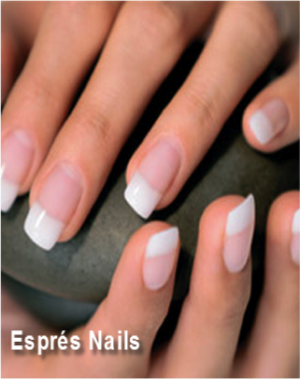Hours: M-W/Th & F: 10-7/8; Sat 10-7; Sun: 11-6; Holiday Hours
Artificial Nail
ACRYLIC
Acrylics are the most popular form of nail enhancement. Recommended for those with naturally weak, brittle nails.
- Full Set with regular polish: $40.00
- Full Set with Shellac/Gel Polish: $55.00
- Fill-ins with Shellac/Gel Polish: $45.00
- Overlay with regular polish: $40.00
- Fill-ins with regular polish: $30.00
- Long nails extra
- French: $6.00 extra
Artificial nails, also known as fake nails, fashion nails, nail enhancements, or nail extensions, are coverings placed over fingernails as fashion accessories. Some artificial nails attempt to mimic the look of real fingernails as closely as possible, while other designs may deliberately stray in look from real fingernails. Artificial nails are made from a wide variety of materials.
The artificial nails are not a replacement, but an extension for natural nails. There are two main approaches to creating artificial nails—tips and forms. Tips are made of lightweight plastic plates that are "nail"-shaped. They are glued on the end of the natural nail and acrylic is then applied over the entire nail. Forms are fitted over the nail and then an artificial nail is molded out of acrylic and the form is removed and then properly shaped and buffed to a shine.
There are several popular techniques that can be used to create longer, better-looking nail enhancements.
One popular material commonly called "acrylics" is a mixture of a polymer powder and a liquid monomer (e.g. ethylmethacrylate). The mixture starts to harden in 30-40 seconds after application and continues to cure to final hardness typically within fifteen minutes. Powder and liquid acrylics can be removed by using a variety of solvents (usually acetone is used). Usually it takes 15 to 20 minutes to remove the nail.
Another material, commonly called "UV Top Coat" (in correct chemical terms a polymer resin) hardens under ultraviolet light. Depending on brand these can show a broader variety of quality and properties (flexibility, strength, etc.) but may be more expensive. They generally cannot be removed by organic solvents, but only be removed by filing (or left to grow out with the natural nail).
Another popular alternative to acrylic or gel preparations are fiberglass or silk wraps. They are done by cutting pieces of actual fiberglass or silk fabric to fit on the surface of the nail or tip and then it is sealed down with a resin or glue. These are a possible alternative for those who are allergic to chemicals used in the acrylic or gel process.
Other materials can be used, as well as combinations of them. There are also temporary, cheaper flexible tips that can be quickly glued at home without help from a professional. Acrylic nail powders are available in a variety of colours and can use "special effects" such as contours, sparkles and the very popular French manicure (pink and white appearance).
BENEFITS OF ACRYLIC NAILS
Acrylic nails are a great option for someone who has a habit of biting her nails or for those who have trouble growing their nails. Some women will use these types of nails to help break the habit of nail biting; other women will use them so they can feel beautiful and have lovely, easy to care for nails. Acrylics can stand up to the abuse that we put our nails through on a daily basis.
Acrylic nails are by far the most popular type of artificial nail on the market today. These nails can completely cover the nail or just a part of it. Acrylic nails are harder than gel nails and the removal process is pretty simple. If one breaks, you can generally fix it temporarily yourself until you are able to get it re-applied by a professional manicurist.
When you are applying and removing acrylic nails, be careful not to damage the real nail beneath it. Normally there should not be a problem, as long as you apply the nails according to the instructions. Once you start wearing acrylic nails, you won't want to stop. Think about when you color your hair: when you stop, your roots show and you have to color it all over again because you hate the way the roots look. When you have acrylic nails and remove them, you are back to your old nails, which may not look so nice anymore, so you will want the acrylics back on as soon as possible! If you had creative acrylic nails, like the hand painted versions, you may miss the design and style they provided and long for the funky style you once had.
There is some maintenance involved in caring for your acrylic nails. Regardless of the quality of the acrylic, there will be some wear and tear over time. You will need to get them touched up every couple of weeks for chips, scratches and loosening glue. If the glue starts to become loose you need to get the nail re-applied or it will fall off. Of course, this is bound to happen at the most inopportune time. It is a classic example of Murphy's Law.
There are different styles and types of nails, so ask your manicurist what the best option is for your nails.


